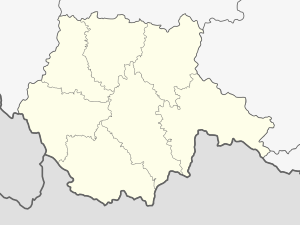Kunžvart Castle
| Hrad Kunžvart | ||
|---|---|---|
|
Remains of the castle |
||
| Alternative name (s): | Kunzwarte, Kuschwarda Castle, Königswart Castle | |
| Creation time : | before 1359 | |
| Castle type : | Höhenburg, spur location | |
| Conservation status: | ruin | |
| Place: | Strážný (until 1955 Kunžvart ) | |
| Geographical location | 48 ° 55 '16 " N , 13 ° 42' 34" E | |
| Height: | 1033 m nm | |
|
|
||
The ruins of Kunžvart Castle ( Czech Hrad Kunžvart ; German Kunzwarte, Burg Kuschwarda, Burg Königswart ) are located in the foothills of the Bohemian Forest , in the area of Horní Světlé Hory (Oberlichtbuchet) 1.5 kilometers northwest of the municipality seat , the minor town of Strážný (until 1955 Kunžvart ) in Okres Prachatice ( Czech Republic ). It is one of the highest castles in the country.
geography
The ruins of the Spornburg are located on the summit of the Kunžvart mountain (1033 m), a sub-peak of Strážný (1115 m, Schlösselberg ).
Surrounding villages are Polka (Elendbachl) Orlovka in the northeast, Kořenný (Schlösselbach) and Strážný in the southeast, Dolní Silnice (country roads) in the south and Horní Světlé Hory (Oberlichtbuchet) in the southwest.
A yellow hiking trail leads from Strážný to the remains of the castle. The difference in altitude is almost two hundred meters. The nearest train station is Lenora (Eleonorenhain) eight kilometers away.
history
The watchtower was probably founded at the beginning of the 14th century on the initiative of Johann von Luxemburg in connection with securing the state border with the Duchy of Bavaria . It was first mentioned in documents in 1359 as Castrum Kungenslen , when King Charles IV. Pešek von Janovice and the sons of his brother Herbart confirmed their inheritance. The castrum Gans (Castle Hus) also belonged to the Janovice family . The importance of Kunžvart Castle grew when Wenceslas IV allowed them to run a branch of the Goldener Steig trade route to the market settlement of Vimperk (Winterberg) and collect customs duties there. The castle was the seat of the burgrave and a small retinue. The castle fell into disrepair from the middle of the 16th century. According to old reports, it was no longer inhabited in 1547, and a fire is documented in 1578.
In 1672 there was a defeat on the Goldener Steig in the village of Bärenloch . It was in 1735 after the desolate castle in Kuschwarda or Kunžvart renamed. After the stationing of units of the Pohraniční stráž (PS) in 1951, Kunžvart received the new name Strážný four years later . The minor city has the castle tower in the coat of arms.
After the first archaeological finds showed that the site was used earlier in the 13th century, further explorations were carried out in August 2000 and 2001 . The investigations in the area of the Spornberg and inside the tower brought up remains of ceramics and horseshoes from the 13th – 15th centuries. Century to the surface. Further finds can be assigned to the Hallstatt period (6th century BC).
investment
The way to the castle led from the west, where the castle was protected by a crevice deepened into a moat . The only stone building was a well-preserved residential tower with a rounded western corner. Above the almost square floor plan with a side length of 10.5 × 10.7 meters, three floors rose. The 15 meter high walls of the tower are 174 to 280 centimeters thick. Three loopholes have been preserved in the south-east wall (two on the ground floor, one on the first floor), the fourth is in the north wall above the entrance. Two of the three large square windows in the living room on the second floor have collapsed. A portal on the ground floor leads into the interior of the castle. Parts of the lining later served as the entrance to farm no. 5 in Kořenný. Other possible extensions as well as a palisade were made of wood. However, there are no remains of these.
The castle ruins have been protected as a cultural monument of the Czech Republic since May 3, 1958 .
See also
- Vimperk Castle (Winterberg Castle)
- List of castles and chateaus in South Bohemia
literature
- Excursus č. 19 Hrad Kunžvart (Kunzwarte) . In: František Kubů, Petr Zavřel: Zlatá stezka. Historický a archeologický výzkum významné středověké obchodní cesty . Volume 2: Úsek Vimperk - státní hranice (VI. Úsek). České Budějovice 2007. ISBN 978-80-86260-82-2 . Pp. 150-172.
- Kunžvart . In: Tomáš Durdík, Viktor Sušický: Zříceniny hradů, tvrzí a zámků. Jižní Čechy . Agentura Pankrác, Praha: 2002. ISBN 80-902873-5-2 . Pp. 57-59.
- Kunžvart hrad . In: August Sedláček: Hrady, zámky a tvrze Království českého. Prácheňsko. Svazek XI . Praha 2000. p. 153.
- Irmine Nussbaum, Fritz Ilg, Gustav Kindermann: Parish Kuschwarda in the Bohemian Forest. Origin - history - displacement . H. Dorfmeister, Tittling 1996. ISBN 3-927454-15-X .
- Paul Praxl : The Road to Bohemia . In: Ernst Dorn : Home on the border . Philippsreut 1997. pp. 175-194.
Web links
- Description on hrady.cz (Czech)
Footnotes
- ^ Kubů, Zavřel: Excursus č. 19 Hrad Kunžvart . P. 153.
- ^ Kubů, Zavřel: Excursus č. 19 Hrad Kunžvart . P. 150f.
- ↑ Sedláček: hrad Kunžvart . P. 153.
- ↑ Stráž can mean waiting, guard or guard .
- ^ Kubů, Zavřel: Excursus č. 19 Hrad Kunžvart . Pp. 152, 156-172.
- ^ Kubů, Zavřel: Excursus č. 19 Hrad Kunžvart . Pp. 150, 155.
- ↑ hrady.cz: hrad Kunžvart . (Czech, accessed December 3, 2019)
- ↑ Durdík, Sušický: Kunžvart . P. 57ff.
- ↑ Sedláček: hrad Kunžvart . P. 153.
- ↑ Hrad Kunžvart, zřícenina ÚSKP 17969 / 3-3762 in the monument catalog pamatkovykatalog.cz (Czech).



